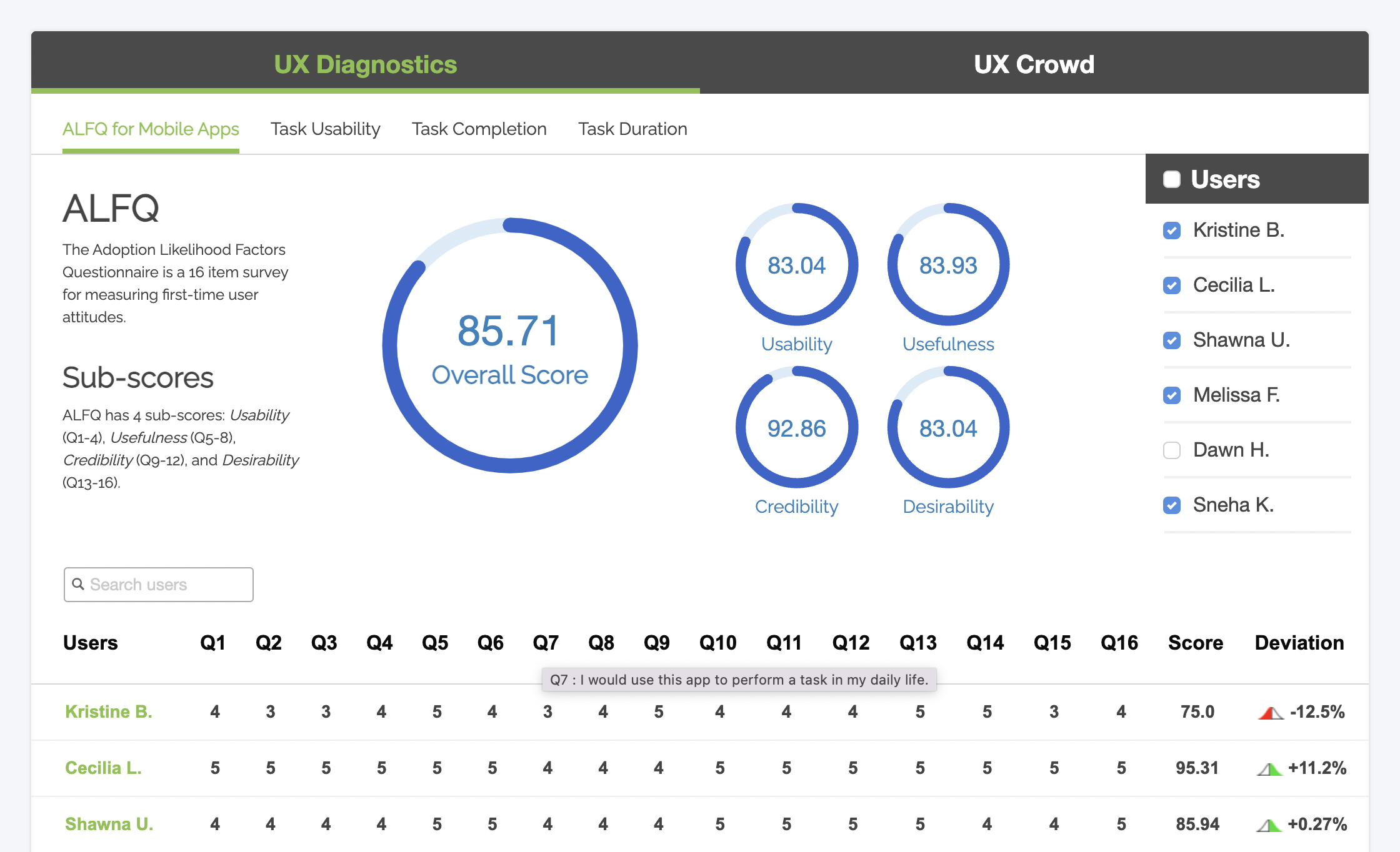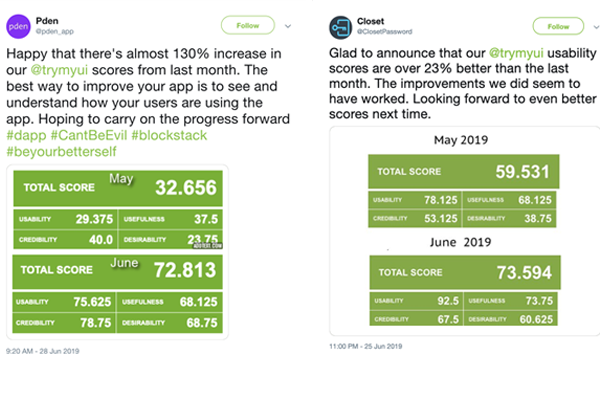
The usability testing space is full of different standardized, quantitative psychometrics that measure the user experience beyond the more subjective qualitative feedback of users. At Trymata, our user testing platform provides all the psychometrics that design & research teams could ever want – including widely-used industry standards like SUS and PSSUQ.
Going beyond the more well-known standards, though, we wanted to provide another option for companies looking for insight into their products’ traction potential with new users.
So we decided to develop our own psychometric survey – the ALFQ – that would serve as a measure of product stickiness and a model for predictive success.
What is the ALFQ?
The Adoption Likelihood Factors Questionnaire (ALFQ) was developed to predict the success of a product (web or mobile) based on 4 different factors that influence a new user’s likelihood to “adopt” (i.e., become a recurring user of) that product:
- Usability
- Usefulness
- Credibility
- Desirability
The questionnaire itself is composed of 16 questions, each of which relates to 1 of those 4 vectors. Taken all together, the 16 questions combine to provide an overall adoption likelihood score for fledgling digital products.
Similarly to the SUS and other psychometric surveys, ALFQ is administered after the video portion of a user testing session. The users respond to the 16 questionnaire items on a 1-to-5 scale, where 1 represents “Strongly disagree” and 5 represents “Strongly agree.”
The 16 questions (and the metrics they measure) are:
- I felt very confident using this website/app. (Usability)
- Learning to operate this website/app was easy for me. (Usability)
- I would imagine that most people would learn to use this website/app very quickly. (Usability)
- I found this website/app easy to use. (Usability)
- I understand what this website/app is for. (Usefulness)
- It was clear to me what this website/app can do for me. (Usefulness)
- I would use this website/app to perform a task in my daily life. (Usefulness)
- I found this website/app to be useful. (Usefulness)
- The information provided by the website/app is believable. (Credibility)
- I felt it was safe to interact with this website/app. (Credibility)
- I would feel comfortable using this website/app’s services. (Credibility)
- I believe this website/app is trustworthy. (Credibility)
- I enjoyed using this website/app. (Desirability)
- I would reuse this website/app in the future. (Desirability)
- I would prefer to use this website/app over similar ones. (Desirability)
- I will recommend this website/app to a friend or colleague. (Desirability)
When your user test results come in, your ALFQ dashboard will show your overall score, as well as individual sub-scores for each of the 4 vectors.
Read more: Quantitative UX metrics with the Trymata UX Diagnostics suite
How does ALFQ differ from other psychometrics?
Put simply, ALFQ focuses on measuring how likely a product is to be successful with new users, instead of on usability or user experience specifically. This means that it will provide a somewhat less granular or precise breakdown of your UX design, but will provide more insight into other aspects of product usage and adoption that other psychometric models don’t consider.
Below is a list of the other built-in psychometric surveys offered by the Trymata usability testing platform, and why ALFQ might be a better alternative depending on your situation.
SUS
The System Usability Scale (SUS) is the most widespread and commonly used psychometric in UX and usability testing, and for good reason. The original, “quick and dirty” UX quantification tool, SUS will give you a reliable overall score for your product’s usability, but lacks any vector breakdowns that offer more advanced insight, like most of the other survey models.
PSSUQ
The Post-Study System Usability Questionnaire (PSSUQ), like SUS, is for specifically measuring usability. Unlike the SUS, it was developed for the sole purpose of administering with scenario-based user tests – so the wording is more precisely chosen for such cases. Neither SUS nor PSSUQ attempts to quantify the non-usability aspects that ALFQ includes.
SUPR-Q
Jeff Sauro’s Standardized User Experience Percentile Rank Questionnaire (SUPR-Q) and our ALFQ are sister psychometrics in their intentionality. Both measure more than just usability, tapping into a wider picture of users’ more abstract thoughts about a product & brand, such as trust and credibility.
Still, ALFQ and SUPR-Q have their differences. We developed ALFQ as a metric for new products, or for products reaching new markets, in order for product owners to better understand their readiness and where they could improve. SUPR-Q, on the other hand, is not focused on any particular product phase. Additionally, the 2 surveys would likely be used for slightly different types of platforms – ALFQ more for ones with a goal to achieve recurring/regular usage, SUPR-Q more for commercial or goal-oriented sites and apps.
Read more: Ecommerce UX and how to test it
SRS
The Survey Respondent Scale is the brainchild of a partnership between Trymata, MeasuringU, and QuestionPro to quantify the cognitive stress of taking a survey. SRS is an extremely specialized metric, meant to be used by marketing teams to ensure that the surveys they send out are well-designed and easy to fill out. By helping companies creating more user-friendly surveys, the SRS in turn helps them to collect more and higher-quality feedback.
When should I use ALFQ?
It might be most helpful to ask yourself, “Where is my product and brand right now on a development/launch timeline, and in the context of our industry?” If you’re preparing a new product for market or looking to attract new customers, ALFQ is a great fit for your study.
The ALFQ is the perfect psychometric tool for estimating both the usage ceiling (potential adoptability) and the floor (how immediately appealing it is) of a product. It takes the best pieces of other psychometrics and turns them into a predictive composite model that teams can shape their roadmap and design decisions with.
We used ALFQ in our partnership with Blockstack to help their base of indie developers iterate and improve on their Blockchain consumer apps over the course of a year. Below are some success stories from some of those Blockstack developers:

User test your product for free today – including ALFQ scores!




